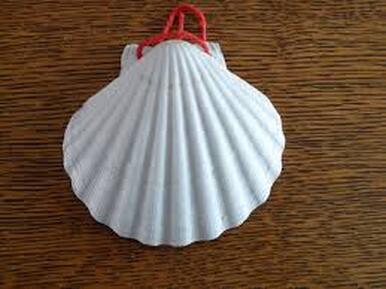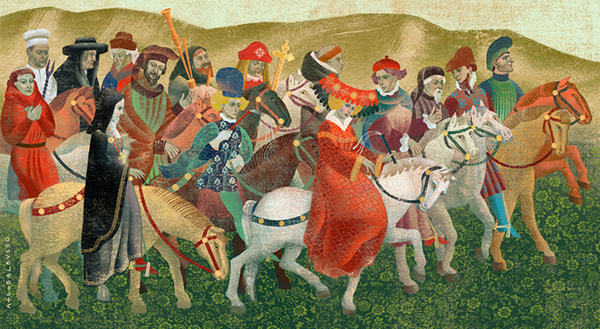 The scallop shell is the symbol of the pilgrimage to Santiago de Compostela. Route markers along the way display the symbol and pilgrims walking the trail tie a shell to their clothing.
The scallop shell is the symbol of the pilgrimage to Santiago de Compostela. Route markers along the way display the symbol and pilgrims walking the trail tie a shell to their clothing. Roger M. McCoy
We often visit places associated with a famous and respected person such as Washington’s home or Lincoln’s home. Sometimes we travel to places of great historical significance such as Gettysburg or the Normandy beaches. People often visit places considered to be sacred for their association with religious history, such as Jerusalem, Mecca, or Bodh Gaya, India, where the Buddha received enlightenment. In addition to these major destinations, there are innumerable other religious sites honored by many different beliefs.
Journeys to these places of significance may be no more than an item on your travel checklist. For many people, however, travel to such sites has special significance, which defines a pilgrimage. Long ago people began making pilgrimages to holy sites and certain routes begun in medieval times are still in use today.
Author Joseph Campbell points out that religious pilgrimages to the Holy Land began as early as the fourth century. Except for a two-hundred year disruption due to Islamic conquests, the number of pilgrims continued to grow over the years. By the eleventh century single expeditions often had as many as 12,000 people.
Medieval pilgrims traditionally carried little food, water, or possessions other than the clothes they wore. Usually they had a walking staff, a purse or bag to hold bread, and a clay water container attached to a strap. Typically they wore a hat, a cloak, and leather shoes. People along the way often offered food to pilgrims believing it would bring blessings to themselves.
Following are accounts of two religious pilgrimage routes in Europe.
The Pilgrims’ Way to Canterbury, England
In mid-twelfth century England King Henry II appointed a friend named Thomas Becket to the important post of Lord Chancellor. In this job Becket enforced the payment of taxes from all landowners, including churches, and became a trusted subject to the King. Becket and the King also formed a strong friendship and often hunted and played chess together.
When the then-current Archbishop of Canterbury died, the King appointed Thomas Becket as the new archbishop. Because Becket was not even a priest in the Church, ordination to the priesthood took place a few days later, followed the next day by ordination to archbishop—a leap from tax collector to archbishop in ten days. Henry II felt confident that having a loyal ally would help in his plan to weaken the English church’s allegiance to Rome and establish himself as the authority. King Henry II persuaded the other bishops to align with his plan to move away from the influence of the pope, but Becket refused to sign the document that would put the king before the pope. Becket seems to have experienced a religious conversion and shifted his loyalty to the Church—not the King.
Henry summoned Becket to appear before a great council to answer allegations of contempt of royal authority. After conviction on the charges Becket stormed out of the trial and fled to the protection of King Louis VII of France. Henry tried to force Becket to return to Canterbury through treacherous schemes, but Becket retaliated by threatening the King with the direst measure: excommunication—meaning the King would never be able to receive the Church’s sacraments. After six years in France and serious negotiations Becket returned to Canterbury. Upon his return Becket excommunicated three noblemen who had been his most bitter foes.
At this point King Henry became enraged and is said to have uttered the notorious words, “Will no one rid me of this troublesome priest?” [Several variations on this statement have been debated by scholars.] The knights who heard King Henry make this statement took it as a royal command and four of them immediately left for Canterbury to murder Thomas Becket. The abbey monks tried to make Becket take shelter, but he refused and knelt at an altar while the knights broke into the doorway. It is recorded by eyewitnesses that the knights cracked open his skull, spilling his brains onto the cathedral floor. Killing an archbishop was indeed a dire crime and Becket immediately became a national martyr. Within days a Becket shrine was established in Canterbury Cathedral and soon became the most important pilgrimage destination in England.
King Henry was horrified when he heard the news and realized his words had caused Becket’s death. As an act of penance he donned sackcloth and ashes, and ate nothing for three days. The king then performed a public act of penance at Canterbury. He publicly confessed his sins, and then allowed each bishop present to give him five blows from a rod, then each of the eighty monks of the monastery with Canterbury Cathedral gave the king three blows. The king then offered gifts to Becket's shrine and held a vigil at Becket's tomb.
Pilgrims began to converge on Canterbury to pay homage to the martyred Becket. Although pilgrims arrived from any direction, the preferred starting point was the cathedral city of Winchester—153 miles from Canterbury—requiring fifteen days of travel. Henry II came from his royal castle in Normandy to a port on the south coast and thence to Winchester to begin his own pilgrimage to Canterbury.
The well-known work written in 1400 by Geoffrey Chaucer, “The Canterbury Tales,” tells of a group of twenty-nine pilgrims of all social classes traveling from London to Canterbury, twenty-four of whom tell a tale written in rhyming verse.
Ready to start upon my pilgrimage
To Canterbury, full of devout homage…
…Some nine and twenty in a company
Of sundry persons who chanced to fall
In fellowship, and pilgrims were they all…
…It seems to me accordant with reason
To inform you of the state of every one…
Each of the twenty-four pilgrims telling a story is identified by trade or profession, including a knight, a miller, a cook, a friar, a merchant, and a physician, plus eighteen others. Historians and literati value Chaucer’s work for its view of life in late fourteenth-century England and the expertise of his writing.
The Way of Saint James (Camino de Santiago de Compostela)
A second example of pilgrimage routes is the road to Santiago de Compostela, Spain. Legends tell that the Apostle James's remains were carried by boat from Jerusalem to northern Spain, where he was buried in what is now the city of Santiago de Compostela. Roads from many parts of Europe converge on a road in northern Spain that follows an earlier Roman trade route westward to the Atlantic coast.
The legend holds that Saint James preached in Spain where he saw a vision of the Virgin Mary. He later returned to preach in the Holy Land and was beheaded by Herod in 44 A.D. His followers then took his body by ship to Santiago de Compostela, Spain for burial as a martyr.
Where there is a martyr there is soon a shrine and a pilgrimage. One unusual aspect of this particular pilgrimage is its association with the scallop shell. One legend explaining the importance of the shell says that the ship wrecked just offshore and Saint James's body was lost. Some time later his body washed onto a Spanish beach covered with scallops.
During the medieval period a scallop shell was worn as proof of completion of the pilgrimage. Today’s pilgrims wear a scallop shell on their clothing or backpack during the trek to Santiago de Compostela. The shell also appears on sign posts marking the route.
The daily needs of pilgrims on their way to and from Compostela were met by a series of hospices with lodging and care for travelers and usually run by a religious order and under royal protection. The hospices expected a donation from the travelers but many poor travelers had little to offer and some had such bad health they could barely complete a day’s journey between hospices.
Pilgrims walked the Way of Saint James for months to arrive at the great church in the main square of Compostela and pay homage to St. James. Traditionally pilgrims touched the pillar just inside the doorway of the cathedral and the pilgrimage was complete. So many pilgrims have now touched the pillar that the stone is partially worn away.
Typically pilgrimages involve a journey to a significant place where a person may experience renewed understanding of themselves. To many, however, the journey itself, not the place, is the significant action.
Sources
Campbell, Joseph. The Masks of God: Creative Mythology. Joseph Campbell. 1973.
The British Pilgrimage Trust. The Pilgrims Ways to Canterbury. Retrieved from website: https://britishpilgrimage.org/portfolio/pilgrims-way-to-canterbury/
Becket Controversy. Retrieved from website:
https://en.wikipedia.org/wiki/Becket_controversy#Aftermath
Henry II of England. Retrieved from website:
https://simple.wikipedia.org/wiki/Henry II of England
Camino de Santiago. Retrieved from website:
https://en.wikipedia.org/wiki/Camino de Santiago

 RSS Feed
RSS Feed
